The Dell XPS 13 (9300) Review: Return of the King
by Brett Howse on July 16, 2020 10:00 AM ESTGPU Performance
One area where Intel-based notebooks had previously was in the graphics department, and with Intel’s launch of Ice Lake they directly addressed that. Along the way, Intel has also joined AMD in more aggressively demarcating their integrated GPUs based on the price of the processor. Intel always had a small bit of variation in the included GPU, but for the most part, a Core i3, i5, or i7 U-series would generally offer the same 24 Execution Unit GPU configuration. With Ice Lake, the naming scheme now includes the GPU size in the processor name, with G1, G4, and G7 graphics options, meaning lower-priced Core i3 and i5 models will not necessarily be outfitted with the same iGPU as a Core i7.
| Intel 10nm Ice Lake-U Series CPUs | |||||||||
| AnandTech | Cores Threads |
Base Freq |
1C Turbo |
AC Turbo |
GPU EUs |
GPU Freq |
L3 Cache |
TDP | |
| Core i7-1068G7 | 4 Cores 8 Threads |
2.3 | 4.1 | 3.6 | 64 | 1100 | 8 MB | 28 W | |
| Core i7-1065G7 | 4 Cores 8 Threads |
1.3 | 3.9 | 3.5 | 64 | 1100 | 8 MB | 15 W 25 W |
|
| Core i5-1035G7 | 4 Cores 8 Threads |
1.2 | 3.7 | 3.3 | 64 | 1050 | 6 MB | 15 W 25 W |
|
| Core i5-1035G4 | 4 Cores 8 Threads |
1.1 | 3.7 | 3.3 | 48 | 1050 | 6 MB | 15 W 25 W |
|
| Core i5-1035G1 | 4 Cores 8 Threads |
1.0 | 3.6 | 3.3 | 32 | 1050 | 6 MB | 15 W 25 W |
|
| Core i3-1005G1 | 2 Cores 4 Threads |
1.2 | 3.4 | 3.4 | 32 | 900 | 4 MB | 15 W 25 W |
|
This comes into play since Dell offers three processor options on the XPS 13, with both the Core i3 and Core i5 variants only offering the G1 graphics. To be clear, even the G1 Generation 11 graphics on Ice Lake are a larger GPU than the previous Gen 9.5 offered, with even the lowliest Core i3 featuring 32 Execution Units, but the full GPU in this laptop is only found if you choose the Core i7 model, which offers the 64 Execution Unit G7 graphics. It makes choosing the processor a bit more complex than it used to be, as it would be on an AMD-based laptop which follows the same mantra.
Dell shipped the XPS 13 review unit with the Core i7-1065G7, and as such this device does feature the full-sized GPU, and as we have seen in other Ice Lake based notebooks, the larger GPU is a significant improvement over previous designs.
3DMark
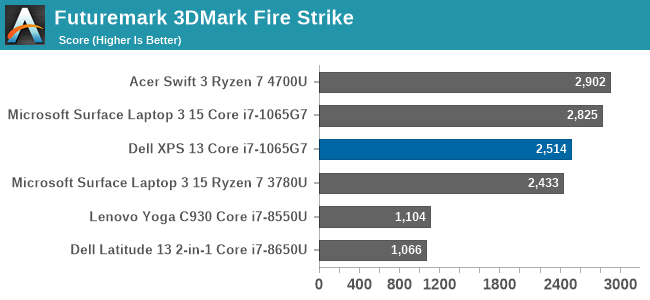
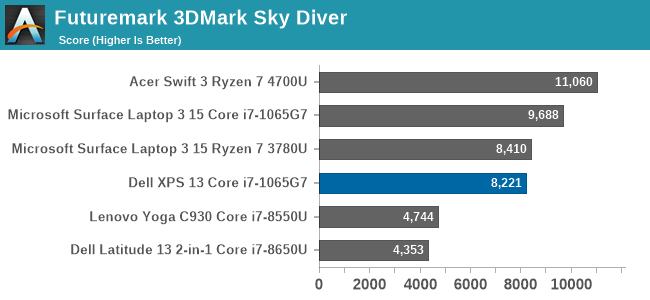

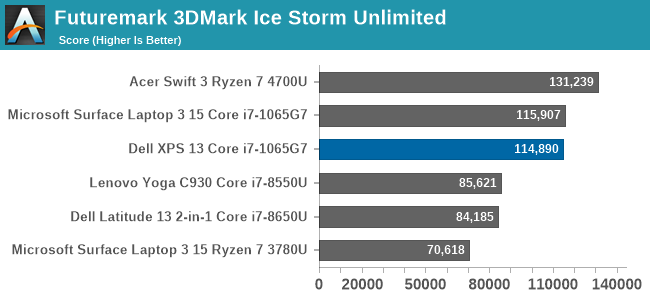
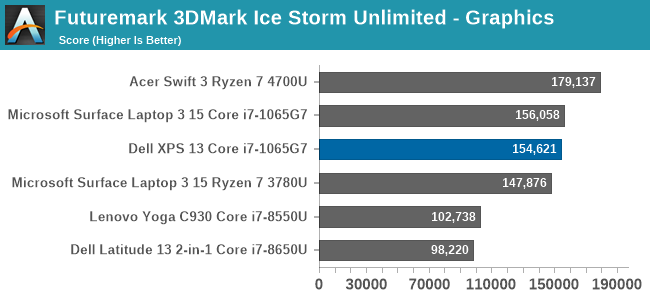
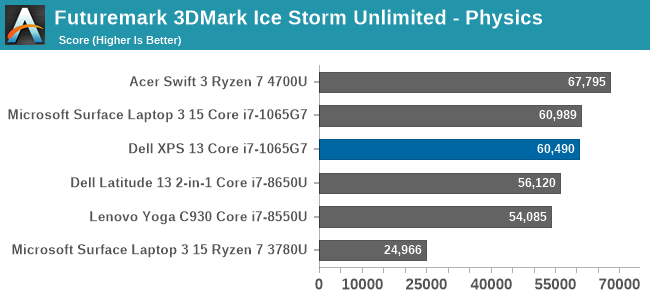
In our first synthetic test, the XPS 13 finishes slightly behind other Ice Lake notebooks, but not by a wide margin.
GFXBench
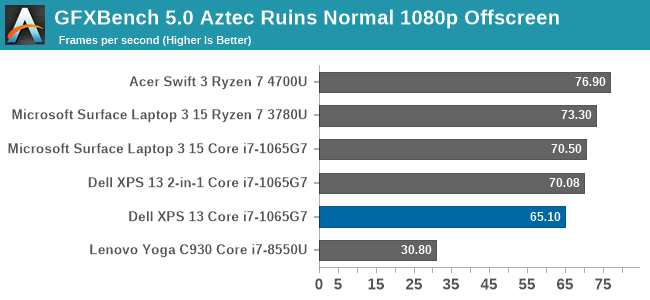

We run the DirectX 12 tests from version 5 of GFXBench, and as expected, the XPS 13 scores right in the same range as expected.
Tomb Raider
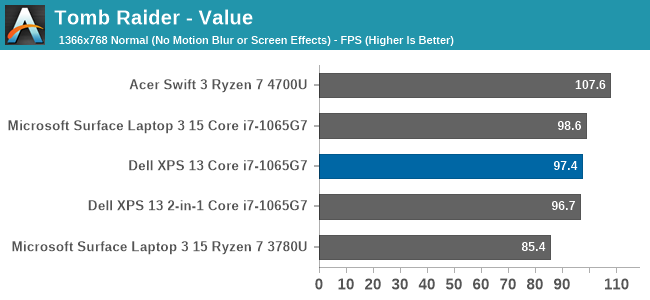
The original Tomb Raider has been a challenge on integrated GPUs, but with AMD’s Ryzen and Intel’s Ice Lake, the game is finally playable although without any extreme graphics settings enabled. Once again, the XPS 13 slots in right where it is expected.
Rise of the Tomb Raider
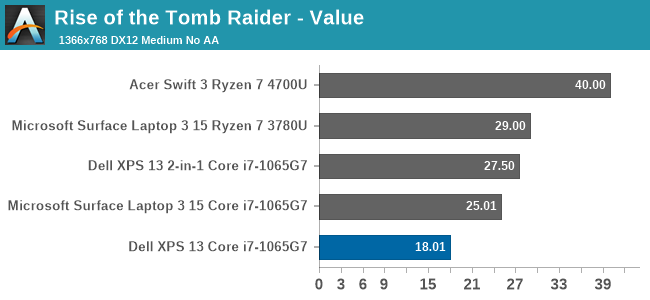
The first sequel to the re-launched Tomb Raider series is much more graphically demanding, and the XPS 13 slides out of the playability window even at the lowest settings we test at.
Strange Brigade
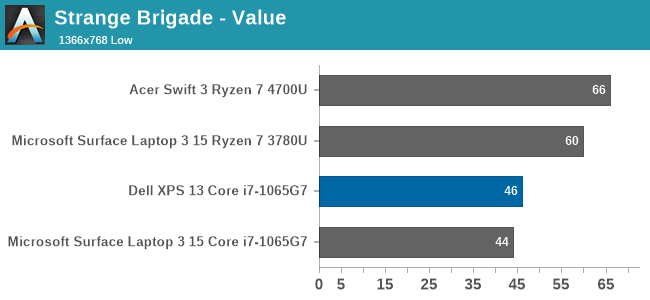
Strange Brigade is a game with a wide-range of settings, and can be very playable even on integrated graphics. As seen with Rise of the Tomb Raider though, the XPS 13 is not quite as performant as some of the other Ice Lake notebooks we have tested.
F1 2019
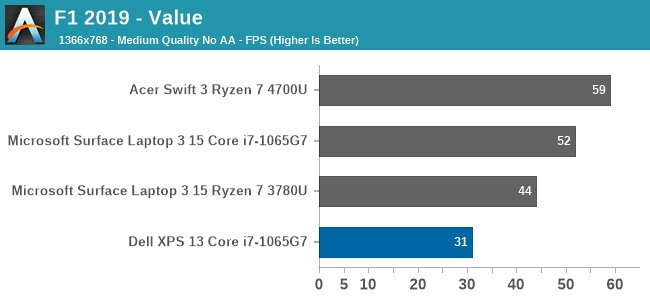
Codemaster’s F1 simulator did not fare very well on the XPS 13, scoring well under expectations. This game can be very CPU limited as well, so TDP can be a major factor.
Far Cry 5

Like most of the other games, we see that Far Cry 5 is once again below other Ice Lake systems, but even on the best integrated system Far Cry is only barely playable regardless.
GPU Conclusion
Although the XPS 13 was outfitted with the top of the range Core i7-1065G7, with its full 64 Execution Unit GPU, the XPS 13 was not quite able to match some of the other Ice Lake systems we have seen. We will get into that a bit more in the thermals section, but this is likely due to Dell more aggressively clamping the processor to its recommended 15-Watt TDP, where other manufacturers may be more aggressive and allow 20+ Watts. Since the GPU is one area where more thermal headroom is always welcomed, this can have a larger impact than a CPU-bound task.
Otherwise, while the Ice Lake G7 GPU configuration is nothing short of a massive step up from Intel's earlier integrated GPUs, they are also competing with AMD in a field that's normally AMD's strength. So for as fast as the G7 configuration is, it and the XPS 13 end up trailing laptops based on the half-a-generation newer AMD Ryzen 4000 APUs.










224 Comments
View All Comments
Deicidium369 - Friday, July 17, 2020 - link
Leaks from Lenovo show Tiger Lake Core i7-1165G7 (not even the top end part) obviously besting the ancient Vega (AMD's choice) and equaling the MX350 - and with only 4 cores only being outran by 17% - double the cores for 17% lead - and when you factor in the flagging GPU - what's the Renoir's advantage again?gescom - Friday, July 17, 2020 - link
Huh, let's wait for amd 5x00 cezanne, shall we?Deicidium369 - Friday, July 17, 2020 - link
Ice Lake is almost a year old. Comparing the latest AMD with an almost year old design should be a win for the newer part. the most appropriate comparison is 2020 vs 2020. That would be Tiger Lakegescom - Friday, July 17, 2020 - link
Tiger Lake Q4 2020 vsamd cezanne Q1 2021.
s.yu - Saturday, July 18, 2020 - link
You think it's the effort? So they haven't been putting all their effort into 10nm?...ok?
Spunjji - Friday, July 17, 2020 - link
As always for a Deicidium post about AMD, Lots Of Citations Needed."Problem with AMD is they are still trying to get Skylake levels of performance"
- They already matched that clock-for-clock with Raven Ridge (at lower clocks, hence lower overall performance), and they have now exceeded it with Renoir.
"Intel has well moved on from that architecture"
- Not really. I'd accept this if they had Sunny Cove or better across most of their range, but they absolutely do not - not even in notebooks, let alone the entire market.
Tiger Lake looks like it'll be a good release, when it arrives in quantity. Problem is that we're talking about today, not Jam Tomorrow.
Santoval - Friday, July 17, 2020 - link
It is still unclear if Tiger Lake will be a high volume release or a low volume release that will need to be released along perhaps Rocket Lake-U/Y, rehashing the way Ice Lake was released along with Comet Lake-U/Y. It should be higher volume than Ice Lake but maybe not high enough to fully supply the U/Y market on its own.Deicidium369 - Friday, July 17, 2020 - link
Well Ice Lake shipped in greater numbers than all of the Ryzen Mobile - so high volume is a relative term. Ice Lake was going to be low volume and relatively niche. Tiger Lake is high volume (not high volume like the Ice Lake SP Xeon) compared to Ice Lake U.I was surprised to see the 1065G7 in an Inspiron class machine at Dell - I had thought it was only the XPS class machines.
Spunjji - Monday, July 20, 2020 - link
@Deicidium - Of course it shipped in greater numbers than Ryzen Mobile! Intel are ~35X the size of AMD - you'd kind of hope they'd be shipping products in larger absolute numbers. I was talking about Sunny Cove as a proportion of Intel's product range, and I was pretty damn clear about that. It's telling that you flipped metrics under discussion to suit your argument."Ice Lake was going to be low volume and relatively niche" - says who? Why? To what end? You're pointing to the results of a sub-par product launch (by Intel's historically high standards) and claiming it was the plan all along. It's just like the AMD fanbois who used to laud the FX 9590's 5Ghz clock speed as if it was an achievement, rather than the best they could salvage from what they had.
You said Intel have "moved on" from Skylake. That's untrue and will remain the case until Rocket Lake, Ice Lake SP and Tiger Lake are out. At that point in time (and not before) Intel will be fully competitive in all areas on a technical level. I'm genuinely interested to see how Sunny Cove on 14nm looks - there's no reason to believe it won't be solidly competitive with AMD on performance, but power draw and die size might not be quite so flattering.
Santoval - Friday, July 17, 2020 - link
"Problem with AMD is they are still trying to get Skylake levels of performance, but Intel has well moved on from that architecture. Intel is solid as they come in ultralights/ultrabooks."That's a very bizarre statement for quite a few reasons :
1. AMD are not targeting Skylake performance levels. When they designed the original Zen they had in mind Cannon Lake - level performance (Intel semi-released a single semi-disabled Cannon Lake 2-core Core i3 in low volume and now they trying to pretend they never did) and when they designed Zen 2 (according to CTO Mark Papermaster) they were targeting it against Ice Lake - not knowing it would be limited to 4-core low power parts. AMD never had Skylake in mind because they never expected Intel would be stuck so many years with it.
2. Intel have not "well" moved on from Skylake at all. They *just* did, at the beginning of the year (still in low volume, hence the dual release with Comet Lake-U/Y, which was the bulk of the release), with low power 4-core mobile parts and they are *still* stuck with it in the form of Comet Lake. Until Comet Lake is replaced by Rocket Lake Intel are still stuck with Skylake, still fabbing and releasing CPUs with an μarch they have been using, reusing and re-reusing and re-re-reusing since 2015. In which parallel universe would that be regarded as "well moved on from that architecture"?